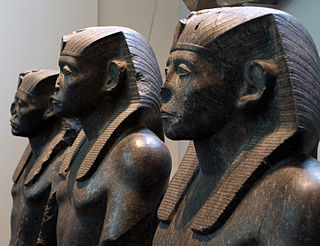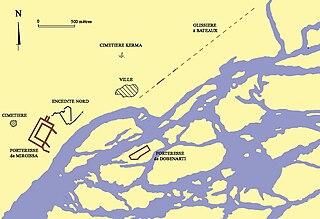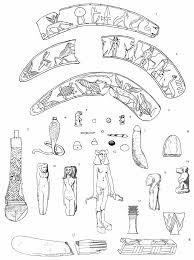Related Research Articles

The Cushitic languages are a branch of the Afroasiatic language family. They are spoken primarily in the Horn of Africa, as well as the Nile Valley, and parts of the African Great Lakes region. Speakers of Cushitic languages and the descendants of speakers of Cushitic languages are referred to as Cushitic peoples. The phylum was first designated as Cushitic in 1858. Major Cushitic languages include Oromo, Somali, Beja, Agaw, Afar, Saho and Sidamo.
Nubians are an ethno-linguistic group of people who are indigenous to the region which is now present-day Northern Sudan and southern Egypt. They originate from the early inhabitants of the central Nile valley, believed to be one of the earliest cradles of civilization. They speak Nubian languages, part of the Northern Eastern Sudanic languages.

The Middle Kingdom of Egypt is the period in the history of ancient Egypt following a period of political division known as the First Intermediate Period. The Middle Kingdom lasted from approximately 2050 to 1710 BC, stretching from the reunification of Egypt under the reign of Mentuhotep II in the Eleventh Dynasty to the end of the Twelfth Dynasty. The kings of the Eleventh Dynasty ruled from Thebes and the kings of the Twelfth Dynasty ruled from el-Lisht.
Medjay was a demonym used in various ways throughout ancient Egyptian history to refer initially to a nomadic group from Nubia and later as a generic term for desert-ranger police.

Menmaatre Ramesses XI reigned from 1107 BC to 1078 BC or 1077 BC and was the tenth and final pharaoh of the Twentieth Dynasty of Egypt and as such, was the last king of the New Kingdom period. He ruled Egypt for at least 29 years although some Egyptologists think he could have ruled for as long as 30. The latter figure would be up to 2 years beyond this king's highest known date of Year 10 of the Whm Mswt era or Year 28 of his reign. One scholar, Ad Thijs, has suggested that Ramesses XI could even have reigned as long as 33 years.
Lower Nubia is the northernmost part of Nubia, downstream on the Nile from Upper Nubia. Sometimes, it overlapped Upper Egypt stretching to the First and Second Cataracts, so roughly until Aswan. A great deal of Upper Egypt and northern Lower Nubia were flooded with the construction of the Aswan High Dam and the creation of Lake Nasser. However the intensive archaeological work conducted prior to the flooding means that the history of the area is much better known than that of Upper Nubia. Its history is also known from its long relations with Egypt.

The Kerma culture or Kerma kingdom was an early civilization centered in Kerma, Sudan. It flourished from around 2500 BCE to 1500 BCE in ancient Nubia. The Kerma culture was based in the southern part of Nubia, or "Upper Nubia", and later extended its reach northward into Lower Nubia and the border of Egypt. The polity seems to have been one of a number of Nile Valley states during the Middle Kingdom of Egypt. In the Kingdom of Kerma's latest phase, lasting from about 1700–1500 BCE, it absorbed the Sudanese kingdom of Sai and became a sizable, populous empire rivaling Egypt. Around 1500 BCE, it was absorbed into the New Kingdom of Egypt, but rebellions continued for centuries. By the eleventh century BCE, the more-Egyptianized Kingdom of Kush emerged, possibly from Kerma, and regained the region's independence from Egypt.

Khakaure Senusret III was a pharaoh of Egypt. He ruled from 1878 BC to 1839 BC during a time of great power and prosperity, and was the fifth king of the Twelfth Dynasty of the Middle Kingdom. He was a great pharaoh of the Twelfth Dynasty and is considered to be, perhaps, the most powerful Egyptian ruler of the dynasty. Consequently, he is regarded as one of the sources for the legend about Sesostris. His military campaigns gave rise to an era of peace and economic prosperity that reduced the power of regional rulers and led to a revival in craftwork, trade, and urban development. Senusret III was among the few Egyptian kings who were deified and honored with a cult during their own lifetime.

Nobatia or Nobadia was a late antique kingdom in Lower Nubia. Together with the two other Nubian kingdoms, Makuria and Alodia, it succeeded the kingdom of Kush. After its establishment in around 400, Nobadia gradually expanded by defeating the Blemmyes in the north and incorporating the territory between the second and third Nile cataract in the south. In 543, it converted to Coptic Christianity. It would then be annexed by Makuria, under unknown circumstances, during the 7th century.

Buhen was an ancient Egyptian settlement situated on the West bank of the Nile below the Second Cataract in what is now Northern State, Sudan. It is now submerged in Lake Nasser, Sudan. On the East bank, across the river, there was another ancient settlement, where the town of Wadi Halfa now stands. The earliest mention of Buhen comes from stelae dating to the reign of Senusret I. Buhen is also the earliest known Egyptian settlement in the land of Nubia. Buhen was also the first and earliest known Egpytian settlement in Nubia.

The term Blemmyes is a demonym employed by Greeks, Romans, and possibly Egyptians to denote Eastern Desert people who appeared in written sources from the 7th century BC until the 8th century AD. By the late 4th century, they had occupied Lower Nubia and established a kingdom. From inscriptions in the temple of Isis at Philae, a considerable amount is known about the structure of the Blemmyan state.
The A-Group culture was an ancient civilization that flourished between the First and Second Cataracts of the Nile in Nubia. It lasted from c. 3800 BCE to c. 3100 BCE.

The region of Semna is 15 miles south of Wadi Halfa and is situated where rocks cross the Nile narrowing its flow—the Semna Cataract.

Uronarti, a Nubian word meaning "Island of the King", is an island in the Nile just south of the Second Cataract in the north of Sudan. The primary importance of the island lies in the massive ancient fortress that still stands on its northern end. This fortress is one of a number constructed along the Nile in Lower Nubia during the Middle Kingdom, primarily by the rulers Senusret I and Senusret III.

Nubia is a region along the Nile river encompassing the area between the first cataract of the Nile and the confluence of the Blue and White Niles, or more strictly, Al Dabbah. It was the seat of one of the earliest civilizations of ancient Africa, the Kerma culture, which lasted from around 2500 BC until its conquest by the New Kingdom of Egypt under Pharaoh Thutmose I around 1500 BC. Nubia was home to several empires, most prominently the kingdom of Kush, which conquered Egypt in eighth-century BC during the reign of Piye and ruled the country as its 25th Dynasty.

Mirgissa was a settlement in Northern state, Sudan. Situated at the 2nd cataract, it contained one of the largest fortresses in Nubia. In the time of Thutmose II, 250 to 450 people inhabited the area. The site was first explored by the English geologist Sir Henry George Lyons in 1892, and was excavated by the French Egyptologist Jean Vercoutter from 1962 to 1969. In addition to the fort, excavations uncovered the remains of two cities, one of which was fortified, a northern enclosure, two cemeteries, a boat slide, and a port. Construction of the Aswan High Dam caused the disappearance of Mirgissa, which now lies under the waters of Lake Nubia.

Shalfak is an ancient Egyptian fortress once built up on the western shore of the Second Cataract of the Nile River and now an island in the Lake Nubia in the north of Sudan. Set up in the Middle Kingdom under Senusret III, it is one of a chain of 17 forts which the pharaohs of the 12th Dynasty established to secure their southern frontier during a time where the Egyptian influence was sought out to be expanded. That is why Shalfak, along with the forts of Buhen, Mirgissa, Uronarti, Askut, Dabenarti, Semna, and Kumma, was established within signalling distance of each other.

The Ramesseum magician's box is a container discovered in 1885–1886 in a tomb underneath the Ramesseum by Flinders Petrie and James Quibell, containing papyri and items related to magical practices..

Nubia is a region along the Nile river encompassing the area between the first cataract of the Nile as well as the confluence of the blue and white Niles or, more strictly, Al Dabbah. Nubia was the seat of several civilizations of ancient Africa, including the Kerma culture, the kingdom of Kush, Nobatia, Makuria and Alodia.
References
- 1 2 3 4 5 6 7 8 Kraemer, Bryan; Liszka, Kate (2016). "Evidence for Administration of the Nubian Fortresses in the Late Middle Kingdom: The Semna Dispatches". Journal of Egyptian Histories. 9: 1–65.
- 1 2 Kemp, Barry (2006). Ancient Egypt Anatomy of a Civilization. London: Routledge. p. 236.
- 1 2 3 4 5 6 7 8 9 10 11 Smithers, Paul (1945). "The Semna Despatches". The Journal of Egyptian Archaeology. 31: 3–10.
- 1 2 3 4 5 6 7 8 Leach, Bridget (2006). "A Conservation History of the Ramesseum Papyri". The Journal of Egyptian Archaeology. 92: 225–240.
- ↑ "Papyrus Ramesseum 18". British Museum. Retrieved 2017-03-13.
- 1 2 Smith, Stuart Tyson (2003). Wretched Kush: Ethnic Identities and Boundaries in Egypt’s Nubian Empire. London: Routledge.
- 1 2 3 Lichtheim, Miriam. "Boundary Stela of Senusret III". Ancient Egyptian Literature Volume 1: The Old and Middle Kingdoms: 118–121.
- ↑ Quibell, J.E. (1898). The Ramesseum. London: Bernard Quaritch.